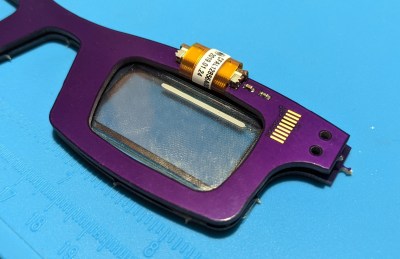Tiny OLED displays are an absolute must-have in the modern parts bin, so what better way to show your allegiance to the maker movement than with a pair of Arduino-compatible OLED glasses? Created by Arduboy mastermind [Kevin Bates], these digital spectacles might not help you see any better — in fact, you’ll see a bit worse — but they’ll certainly make you stand out in the crowd at the next hacker con. (Whenever we can have one of those again, anyway.)
The key to this project is a pair of transparent CrystalFonts OLED displays, just like the ones [Sean Hodgins] recently used to produce his gorgeous volumetric display. In fact, [Kevin] says it was his success with these displays that inspired him to pursue his own project. With some clever PCB design, he came up with some boards that could be manufactured by OSH Park and put together with jewelry box hinges. Small flexible circuits, also from OSH Park, link the boards and allow the frames to fold up when not being worn.
 The Arduglasses use the same ATmega32U4 microcontroller as the Arduboy, and with a few basic controls and a small 100 mAh rechargeable battery onboard, they can technically run anything from the open source handheld’s extensive software library. Of course, technically is the operative word here. While the hardware is capable of playing the games, [Kevin] reports that the OLED displays are too close to the wearer’s eyes to actually focus on them. That said the ability to easily create software for these glasses offers plenty of opportunity for memes, as we see in the video below.
The Arduglasses use the same ATmega32U4 microcontroller as the Arduboy, and with a few basic controls and a small 100 mAh rechargeable battery onboard, they can technically run anything from the open source handheld’s extensive software library. Of course, technically is the operative word here. While the hardware is capable of playing the games, [Kevin] reports that the OLED displays are too close to the wearer’s eyes to actually focus on them. That said the ability to easily create software for these glasses offers plenty of opportunity for memes, as we see in the video below.
For reasons that are probably obvious, [Kevin] considers the Arduglasses an experiment and isn’t looking to turn them into a commercial product or kit. But if there’s interest, he’s willing to put the design files up on GitHub for anyone who wants to add a pair of Arduino glasses to their cyberpunk wardrobe.
















really a neat bit of work! “the OLED displays are too close to the wearer’s eyes to actually focus on them.” though…lol
Use a VuFine screen (although would require it to be on the outside of lens.. and not a true ‘transparent screen’) :(
Is only this could also take HDMI input!!
Would it work as a HUD, connect it to a smartwatch, measure your pulse and display a stamina bar like in an RPG, now that would be awesome :D
Unless you’re extremely nearsighted, no :)
My ears hurt at the sight of those frames!
seems like a good place to use clear epoxy
Heat shrink tubing.
They are not bad at all, and actually I sanded the little nubbins off too.
Hi Tom,
in a similar vein, maybe worth linking to Alain Mauer’s project: https://hackaday.io/project/12211-arduino-glasses-a-hmd-for-multimeter/ which got featured on hackaday before: https://hackaday.com/2017/06/04/__trashed-15/
“And then a miracle happens…”
All I would have to do to see the displays clearly would be to take out my contacts! I would just have to sacrifice some of my far vision.
(Okay, I know that’s not how it works. Don’t freak out.)
My right eye is so nearsighted that when I was 30 and younger I could focus as close as 1″. Was quite handy to be able to slide the contact lens aside and get close to read tiny, low contrast printing on microchips.
You know the presbyopia is creeping up when your focusing speed starts to slow to the point where you notice your eyes adjusting, then it gets to the point your arms aren’t long enough for reading books and if you sit far enough from the computer monitor to read it you can’t reach the keyboard. ;P
Can you play tetris by blinking of a eye?
Hi, what about using the same method for making DIY 3D displays (UV glue deposition via SLS) and make an array of very small droplets to act as lenses?
Would be a sparse array but thats not a big problem.
As adjacent pixels aren’t used it should draw less power than normal permitting higher brightness.
Very interested in this project for my kids, they’d love to build this.
Very Wrench’s mask from Watch Dogs 2-esque. I love it
A different take on Joo Janta 200 Super-Chromatic Peril Sensitive Sunglasses. Can they be made into GPS Sunglasses? http://www.technovelgy.com/ct/content.asp?Bnum=111
Very nice! But just imagine those with LCD displays instead!! You could have animated shades!
Or Joo Janta 200 Super-Chromatic Peril Sensitive Sunglasses
Where did he get this small battery? I’m looking for sellers who sell such tiny batteries(<= 100mAh), but it's hard to find one and lots of them never arrived when I ordered them on aliexpress or ebay.
Power level only 5?